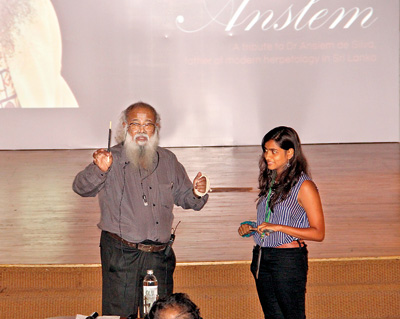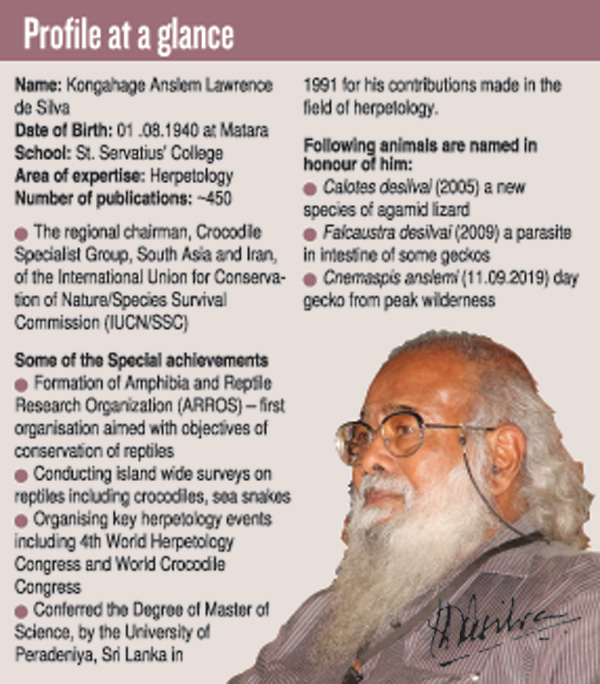News
Snake specialist charmed by the attention
Dr. Anslem de Silva has been honored as the ‘Father of Modern Herpetology in Sri Lanka’ at a global gathering of scientists studying tropical biodiversity.

The former magician turned herpetologist performing an act at his felicitation ceremony. Pic by Madhava Botheju
The one-time magician has generated more than 450 publications during 50 years and inspired almost all the next generation herpetologists of the country.
Dr. de Silva was felicitated on September 12 by the Association of Tropical Biology and Conservation’s Asia-Pacific held at MAS Athena premises at Thulhiriya from September 10-13.
“I was a magician before becoming a herpetologist,” Dr de Silva revealed.
Most Sri Lankans know him as the leading herpetologist studying reptiles – snakes, crocodiles, and lizards.
He has also won a number of magic contests and even published 22 papers on magic. His first paper had been published in an international journal in the United States.
“My dad used to show a few tricks to me when I was a kid. That made me interested in becoming a magician. I used to practice magic at school and sometimes visited other schools to perform – specially the girls’ schools. When I was young, I was a big Romeo,” Dr de Silva said.
Tricks such as bottle balancing, lifting a chair with the mouth, and fire juggling are some things he was at first good at, but he learned more.
“I later became a leading magician in the country winning two national awards. I had two massive evening shows. Performing from Matara to Jaffna and I was very popular in Jaffna,” Dr de Silva added.
He later became interested in snakes.
While studying at Matara St.Servatius College, he once rescued a rat snake that had suffered at the hands of senior students.
“I just grabbed it and threw it into a thicket. I wasn’t scared, and the snake didn’t bite me. After that, I reared a few non-poisonous snakes, a baby saltwater crocodile, and a few sea turtles,” Dr de Silva said. In the evenings, he would go in search of geckos and villagers started calling him ‘Hoony Mahaththaya’ (Mr Gecko).
At the age of 17 years, he got a copy of the “Snakes of Ceylon” written by then expert Frank Wall. He still considers this as a definitive guide.
“Our house was in the Fort premises of Matara where the famous ‘Pacha gaha’ stood near the courts where a lot of snake charmers gathered. I used to watch them handling snakes and used to talk with them to get more information.’’
He became one of the leading figures in the field of conservation of amphibians and reptiles of the country engaging in some pioneering work.
Dr de Silva was the founder president (1990) of the Amphibia and Reptile Research Organisation of Sri Lanka (ARROS) an NGO dedicated to conserving the amphibians, reptiles. and their habitats.
His contributions towards the conservation of amphibians was instrumental in him being nominated as the chairman for Declining Amphibian Populations Task Force, World Conservation Union (IUCN) for Sri Lanka and he is the current co-chairman of the Amphibian Specialist Group of the World Conservation Union.
He also made a significant contribution towards creating public awareness of reptiles and amphibians by publishing the first series of posters illustrated with colour photographs in 1990 and 2001.
At the event, the organizer, Dr Ruchira Somaweera who is now in Australia recalled how he entered the field of herpetology.
“One day I saw the poster ‘Snakes of Sri Lanka’ by Anslem de Silva. This made me visit him and he gave me a magazine in which he wrote, ‘may this inspire you to be a herpetologist’. That spark created a hobby. That hobby created passion and that passion made me work in herpetology as a job. And now that has become a lifestyle,” said Dr Somaweera honoring his guru.
Both young and senior herpetologists shared similar stories at the felicitation, but Dr de Silva accepts tributes with humility, saying “I’m really wondering whether I did all these funny things for you”.
He worries that Sri Lanka’s snake population is declining.
“When I was a young kid, I used to see lot of snakes, but not now. Even road kills are becoming less. There is a massive decline of reptiles of the country. Habitat destruction is the main reason,” Dr de Silva said.
Though closer to 80 years, he continues field work and conservation efforts. He said he is happy that his son Panduka de Silva who works as a naturalist, is also involved in crocodile conservation. Panduka had done a study of some locations of Andaman islands where crocodiles became a problem.
| Anslemi the gecko named after guru | |
| Geckos received much attention in the past few weeks since researcher Sameera Karunarathna and his team named six new geckos after past warriors stirring controversy. In parliament lawmaker Wimal Weerawansa called it disgraceful. But the same researchers named another gecko new to science found in the foothills of Peak Wilderness forest Cnemaspis anslemi. “Anslem is my inspiration and I wanted to be an ‘Anslem’” said Dr Ukuwela, “So we wanted to name our new find after our guru.’’ Mr Karunarathne first read about Dr de Silva during the time he was studying for his Ordinary Levels in 1995. He first wrote to Dr des Silva after reading an article in the Vidusara newspaper about a book on snakes by Anslem de Silva and there was an address. He was thrilled to get a reply in a few days with a number of posters and few other publications signed by Dr de Silva. “It was like a letter from the American president. The letter was signed and I still have it,” said Mr Karunarathna. “I’m really honored to have a gecko named after me and I congratulate the researchers,” Dr de Silva said, graciously. |

